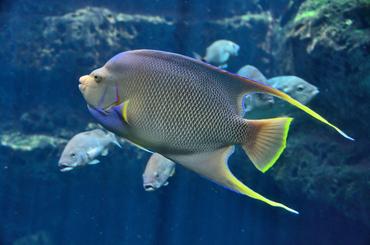WHAT YOU NEED TO KNOW ABOUT PH IN MARINE AQUARIUMS

Updated
Maintaining proper water quality in your tank is essential but many aquarium hobbyists overlook one important aspect - pH. Keep reading to learn more about the importance of pH in a marine tank.
The key to cultivating a healthy and thriving aquarium is to maintain high water quality in your tank. The quality of your tank water is impacted by a number of different factors including the number of fish you keep, the amount and type of food you offer, the frequency with which you change the tank water, and the quality of your filtration system. If you stick to a routine for maintenance and avoid overfeeding your fish, it shouldn’t be difficult to keep the water quality high.
Another aspect of water quality in an aquarium is water chemistry – this includes things like the hardness of your tank water, the salinity, and levels of certain toxins like ammonia and nitrate. One component of water chemistry that many aquarium hobbyists overlook but is actually very important is pH. Keep reading to learn more about the importance of pH in a marine tank and how to manage it.
What is the pH Scale?
In technical terms, pH is the measure of the concentration of hydrogen ions in a solution. In more simplistic terms, pH is a measure of the alkalinity or acidity of a liquid. Measurements of pH are taken on a scale from 1 to 14 with 7.0 being a neutral value – measurements below 7.0 are acidic and measurements above are alkaline. Though different species of fish and other tank inhabitants have slightly different preferences for pH, the ideal range for a marine aquarium is between 7.8 to 8.5, though a pH of 8.2 is ideal because that is the pH of natural seawater.
To measure the pH in your tank, you’ll need some testing equipment. One option is to purchase a pH kit that comes with a liquid test solution and a color chart. To use this type of test kit, you simply fill a test tube with tank water then add a few drops of the liquid test solution. The water will change color once the test solution is activated and you simply compare the color of the liquid to the color chart to determine the approximate pH. Another option is to invest in an electronic pH monitor – this is a device that displays a continuous LCD display of the pH in your tank. These monitors can also be set to set off an alarm if the pH drops too low or goes to high. It is recommended that you test your pH twice a week.

Why is pH Important in a Marine Aquarium?
Many aquarium hobbyists assume that pH is just another aspect of water chemistry that needs to be monitored, though they often don’t understand why pH is important. Maintaining the right pH in your marine tank can actually help to keep your fish healthy. A pH range between 8.1 and 8.4 in marine tanks has an antiseptic effect, protecting your fish against various diseases – it also helps any corals in the tank to calcify more quickly. Fluctuations in pH, as is true for any tank parameter, can be harmful to your fish. Changes in tank parameters are very stressful for fish and, once your fish become stressed, they are at a higher risk for getting sick. Testing your pH regularly is important to prevent this from happening – it will also help you to keep an eye on the water quality in your tank, letting you know if there is some kind of problem developing that may not be obvious.
What Causes Low pH in a Saltwater Tank?
Though your marine fish may be able to survive at pH ranges between 7.8 and 8.5, the ideal range is between 8.1 and 8.4. In a marine tank, low pH is a more common problem than high pH, though both can be dangerous. One of the most common causes for low pH in a marine tank is too much carbon dioxide. This could be a result of using a CO2 reactor in the aquarium or it could be an issue of aeration. The pH in your tank tends to change overnight as photosynthetic organisms slow their production of oxygen due to a lack of light for energy. The rest of the organisms in your tank will continue normal respiration, however, which may lead to higher levels of CO2 and therefore lower pH.

Tips for Resolving pH Problems
The proper steps to resolve issues with pH in a marine aquarium may vary depending on the cause of the problem. Here is an overview of methods for improving pH based on the underlying cause of the issue:
- Use of CO2 Reactors – The use of a calcium carbonate or CO2 reactor is a common cause for low pH in marine aquariums. These devices work by using acidic carbon dioxide to dissolve calcium carbonate as a means of increasing the acidity of tank water. Unfortunately, sometimes the used CO2 doesn’t get blown back out of the tank as it should, so it becomes concentrated in your tank water and lowers the pH. To resolve this issue, you need to adjust your CO2 reactor properly as your first step. You can also use limewater or another alkalinity supplement to raise the pH.
- High Indoor CO2 Levels – If the carbon dioxide levels in the air in your home are too high, it could become concentrated in your tank water. Excess CO2 in the air may be the result of unvented appliances burning natural gas, or it could be caused by respiration of people and pets in the household. To resolve this issue, you can try opening a window near your tank to get rid of excess CO2. Another option that requires a little more work is to run tubing from the outside and connect it to the air input on your protein skimmer. Just be mindful of using this option in an area where there might be insecticides or other toxic chemicals in the air.
- Low Alkalinity – If the alkalinity level in your tank is too low, it could lead to low pH. The calcification process in a marine tank removes alkalinity from the water and, if you don’t supplement the alkalinity as fast as it is being depleted, you could end up with low pH. The ideal solution for this particular problem is, of course, adding more alkalinity to the tank.
- Nitrogen Cycle – Another cause for low pH that hasn’t been mentioned yet is the nitrogen cycle. This is the cycle through which beneficial bacteria convert ammonia, a byproduct of the process through which organic wastes are broken down, into nitrites and then nitrates. If you add inhabitants to your tank before it has finished cycling, it could throw your water chemistry out of whack and the excess acid being produced in the tank might lead to the degradation of CO2 and lowered pH. The solution here is to fully cycle your tank before adding inhabitants.
Maintaining a thriving marine tank can be full of challenges but success is its own reward. If you are having trouble maintaining the proper pH level in your tank, take the time to determine the underlying cause and then address it as needed. Once you get your tank pH back under control, your fish will be happier and healthier.































































































